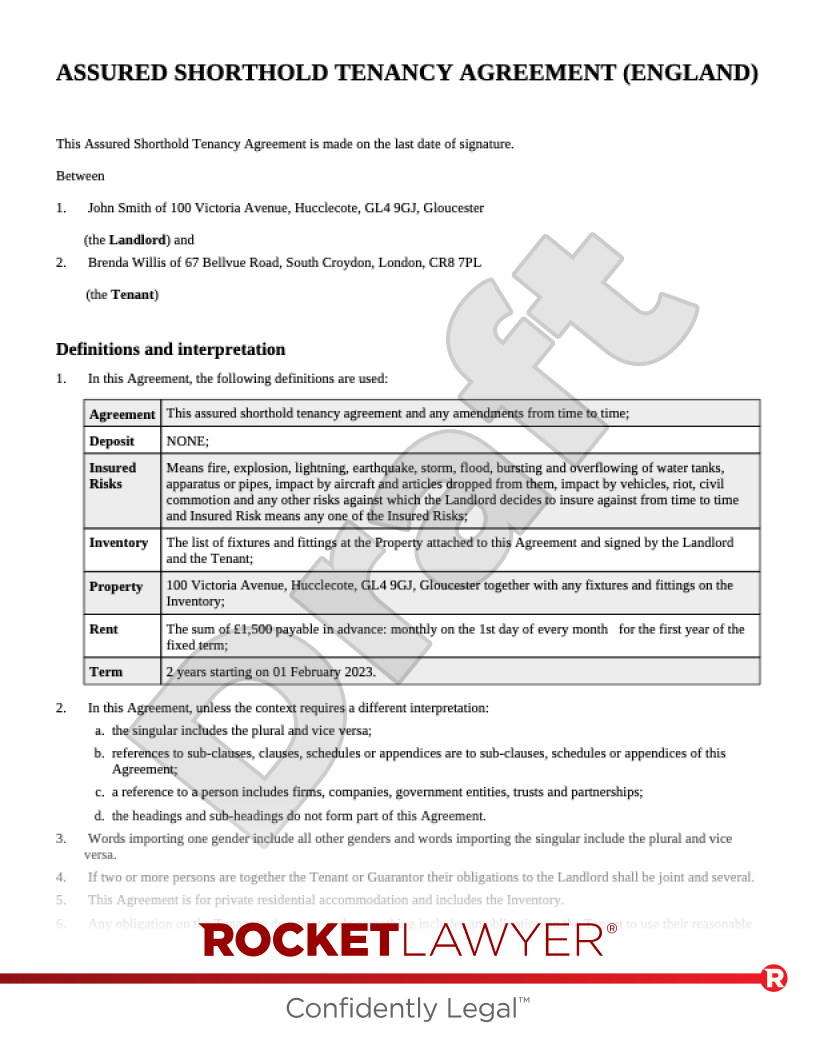Letting documents
It is important to use the correct document so that the tenant does not obtain rights in the property and so that you can easily remove the tenant if they do not pay the rent or breach any obligations in the agreement. If the wrong type of document is used, a tenant may obtain rights to remain at the property. As a tenant, you want to make sure you have the security of tenure you need and the landlord has obligations to maintain the property and not disturb you.
Choosing the right tenancy agreement is also important when seeking a mortgage, as mortgage contracts often contain a term that requires the homeowner to get the lender’s permission before renting out all or part of the property. For more information, read Tenants’ and owners’ obligations.
Assured shorthold tenancy
An assured shorthold tenancy (AST) is a tenancy that gives the tenant the exclusive right to use and occupy a house or flat and is the most popular kind of residential tenancy in use in England.
Under an AST the owner will not live at the property and the tenant is given the use of the property for a set time, which would usually be 12 months.
The owner can get possession of the property after the first 6 months by following the set procedure. Rocket Lawyer’s Tenancy agreement for a flat and Tenancy agreement for a house are ASTs.
A tenancy can be an AST if all of the following apply:
-
the property is private
-
the tenancy started on or after 15 January 1989
-
the property is the tenant's main accommodation
-
the landlord doesn’t live in the property
A tenancy can’t be an AST if:
-
it began or was agreed before 15 January 1989
-
the rent is more than £100,000 a year
-
the rent is less than £250 a year (less than £1,000 in London)
-
it’s a business tenancy or tenancy of licensed premises
-
the property is a holiday let
-
the landlord is a local council
Periodic tenancies
A periodic tenancy is a tenancy that runs from month to month, or less commonly from week to week. Periodic tenancies can either be statutory or contractual.
There will be a statutory periodic tenancy in place if:
-
the previous tenancy agreement had a fixed term
-
the end date has passed but the tenant still lives there
-
the agreement didn’t say that it would become a periodic contract at the end of the fixed term
A contractual periodic tenancy will arise if the last agreement was either a:
-
rolling tenancy contract with no end date
-
fixed term tenancy with a clause saying it would become a periodic contract when the fixed term ended
It is also an option to create a periodic tenancy from the start rather than a fixed term (ie for 6 months or a year). To do this you can give your tenant an initial term of just 1 month (or even just 1 week) and then just allow it to run on. It automatically turns into a periodic tenancy.
Lodger agreement
A lodger agreement gives a lodger the right to use a spare room in a property.
Under a lodger agreement the owner will live at the property and the lodger is given use of a bedroom and has the right with the owner to use other areas in the property such as a bathroom, kitchen and garden.
The owner can end the lodger agreement if the lodger is late in paying the rent or breaches any obligations in the agreement by following the set procedure.
As a landlord, you might not be able to enter into a lodger agreement if you are seeking a mortgage, as many lenders only accept shorthold tenancy agreements to grant a mortgage. For more information, read Taking in a lodger.
Create your Lodger agreement.
Holiday lets
Under a holiday letting agreement, the owner will not live at the property and the holidaymaker is given full use of the property for a set (short) period of time, usually between 1-3 weeks.
The holidaymaker does not get any right to stay in the property after the set period and the owner can obtain possession of the property by following the set procedure. For more information, read Holiday lets.
Room rental agreement
A room rental agreement is a type of AST and allows the occupier to have full use of a room in a property with other people occupying other rooms.
Under a room rental agreement the owner will not live at the property and the occupier has the right to use a bedroom at the property and the right to use other rooms along with other occupants.
A separate agreement is granted to an occupier for their room at the property and there can be up to a maximum of three unrelated occupiers at the property in total.
The owner can get possession of the property after the first 6 months by following the set procedure. Create your Room rental agreement.
What about residential tenancies in Wales?
Since 1 December 2022, the situation regarding residential tenancies in Wales is different to the situation in England. Under the Renting Homes (Wales) Act 2016, most residential tenancies have been replaced by ‘occupational contracts’. For more information, read Residential tenancies in Wales.
What about residential tenancies in Scotland?
The situation regarding residential tenancies in Scotland is different to the situation in England and Wales. For more information on letting residential properties and the documents required in Scotland, read Residential tenancies in Scotland.




